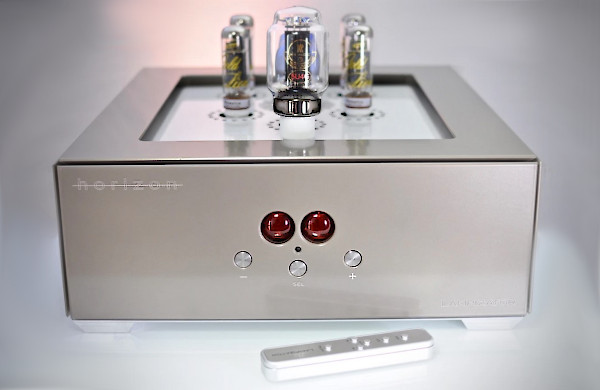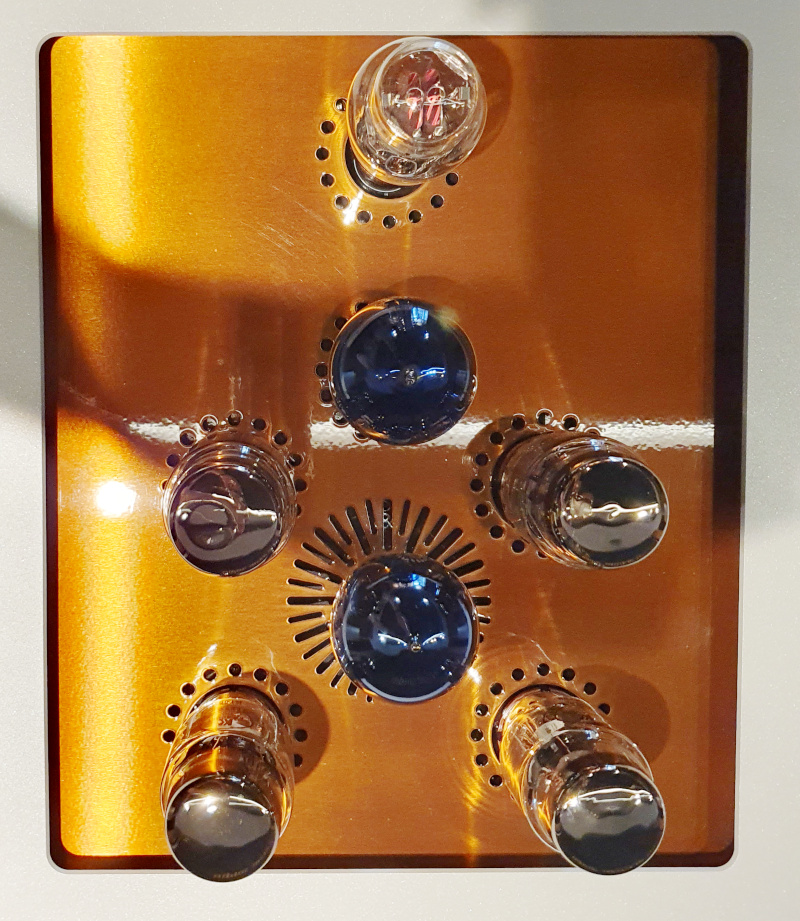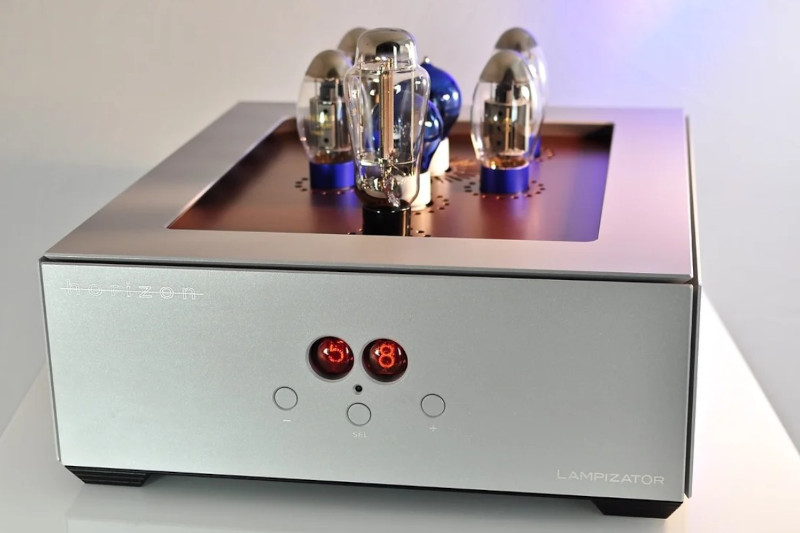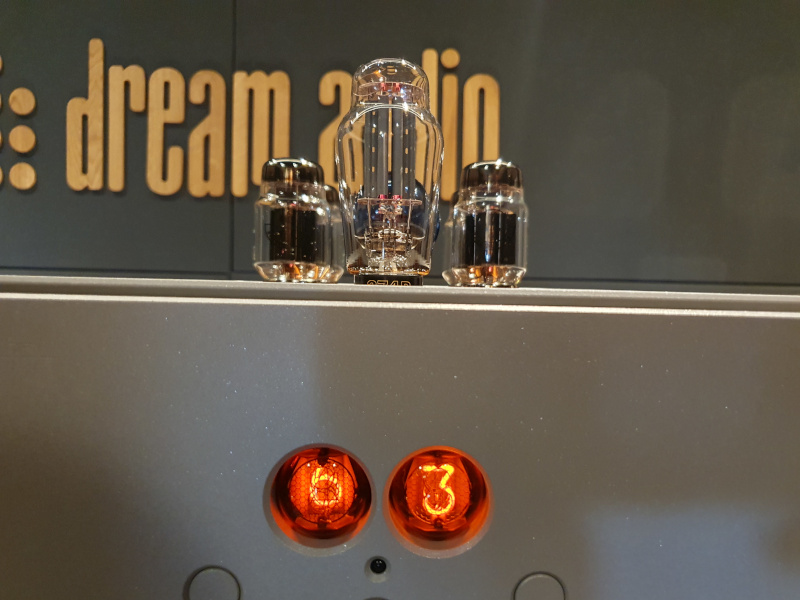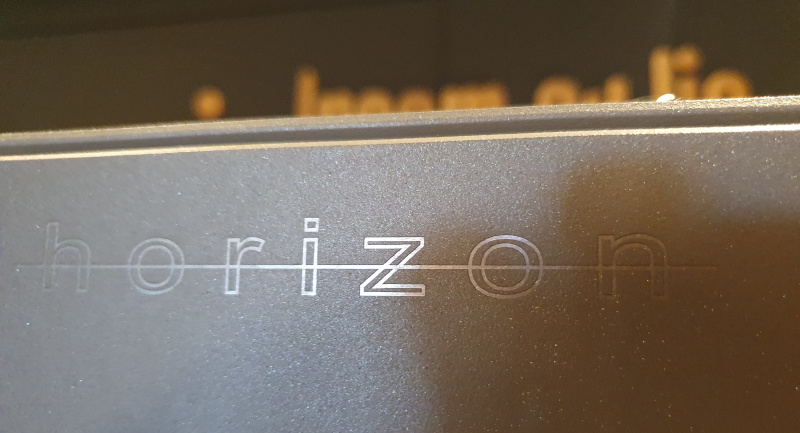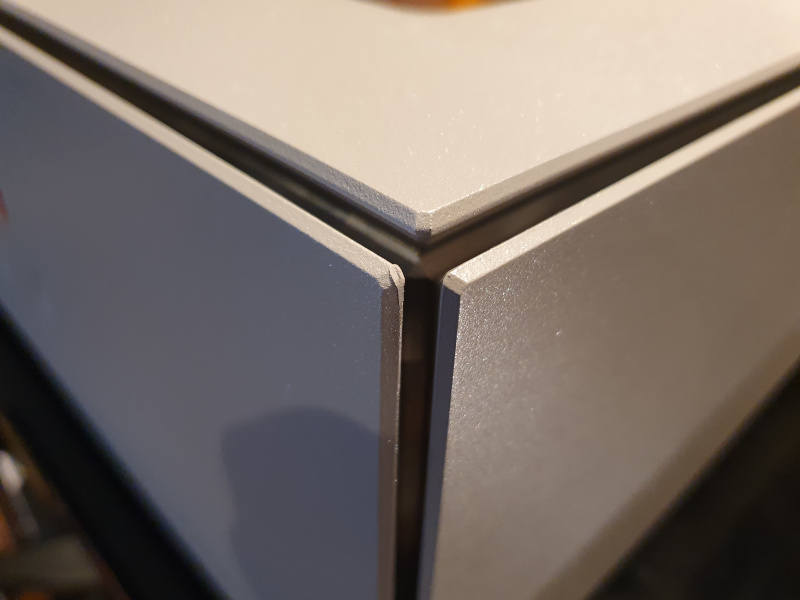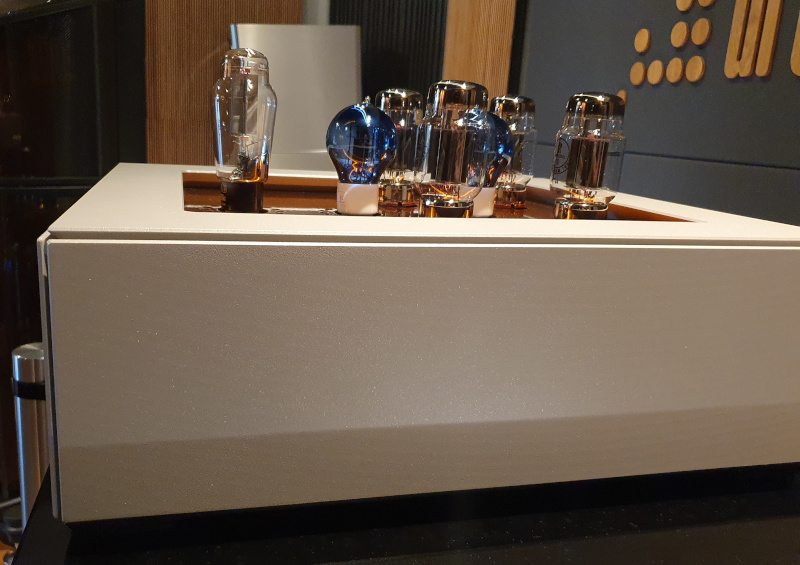LAMPIZATOR Horizon DAC
Digital sources
The manufacturer’s website suggests that the name of Lampizator is a playful combination of Polish expression for tubes (lampa) and Terminator. However, it also can be translated as ‘Tube sound maker’ which is much closer to what the Horizon really does. Using tubes as a primary solution for a DAC seems to be not a good proposition to start with, especially if you seek an answer to the question why would anyone care about adding analogue distortion to pure digital data, it just makes no sense, does it? It is your ears that are providing the answer – for pleasure, man, for pure pleasure…
Function and form
The manufacturer does not give away any details about the Horizon. It is said to be built around “custom transformers, custom four-layer PCB, 17 separate power circuits, ultra-high-end music conversion topology, customized muting solutions, proprietary firmware and software, the chip that revolutionizes the industry, new tube scheme, new tube selection, new chassis, new heating scheme, new volume control with bypass feature, new uber cool Nixie display, elimination of knobs, elimination of LCD and OLED displays, new USB solution with super-clocking, antivibration CNC milled support for all PCBs, and elimination of visible screws”. The website also says that “This DAC [is] so advanced that it is probably 4x more advanced and sophisticated compared to what the industry standard is”. What is known is that the device does not use any kind of feedback, that there are no op amps inside, and that silver wiring is used throughout. In the tube compartment there are four KT88 power pentodes (KR Audio), two 6SN7BE dual triodes (PSVANE), and a power rectifier tube. All the tubes sit in the top plate that is available in 5 colours: black matte, aluminium silver, chrome, red, and copper lacquer.
On its inputs, the Horizon automatically recognizes sampling rates between 32Hz and 768 kHz, and bit rates of 14/32. The manual warns against using S/PDIF for 192kHz files, which, they say, generate too much distortion. They also flag that S/PDIF cables and RCA cables should not be longer than 1.5m and that USB cables must not have ferrite filters on them. In case of USB, the DAC automatically recognizes DSD and plays it as such. The digital inputs are available also as Toslink, AES/EBU, HDMI, and I2S. The Horizon (unusually for a tubed device) is a balanced device and prefers to be used with XLR inputs/outputs. Inclusion of stereo subwoofer XLR outputs is also quite a rare feature.
The chassis is a robust slab of metal which looks much better in reality than in the pictures. The Nixie display is definitely the Horizon’s main attention point – the tube-like display shows numeric characters that inform about the volume level and the number of the input that is used. The volume and inputs can either be controlled by three buttons on the fascia, or via a nice-looking CNC’ed remote controller. Lampizator is the first audio company I know who recommends using a good power conditioner with a good power aftermarket power cord with the device, as well as they encourage experimentation with the tubes to find your personal best sounding combination.
Bass management
The Horizon was connected to the system via its balanced XLR outputs. The volume control section of the DAC was bypassed (that is set to zero attenuation) and Ypsilon PST100 preamplifier was used to provide gain and adjust the volume. The purpose was to listen to the DAC in his ‘fully open’ mode, as a DAC only, without the signal passing through any extra circuitry. It is also important to note that (with the manufacturer’s approval) the front rectifier tube was replaced by TA-274B Takatsuki, which is a rebuild of Western Electric standard. I did not audition the Horizon with its stock rectifier tube but was said that the Takatsuki was a “major improvement”.
I promised to deliver an honest review, so let’s kick off with the key fact: Lampizator is proud of its tubed origins and the Horizon is audibly departing from what I would describe as uncoloured neutral sound. Its fingerprint was heard from the first track I played, which happened to be Rebecca Pidgeon’s Spanish Harlem (FLAC 88.2kHz/24bit). All the acoustic instruments in this beautiful piece had a magic potion quality, a sort of ripe fruity richness. Then it comes down to personal preferences, as some like fruits fresh and sour, some love it ripe, full of sweet fructose. The Horizon’s ripeness paired well with Rebecca’s voice, the double-bass and the violin, less so it was appropriate to the piano and strings, that I felt were way too smooth and romantic, and lacked leading edge transient dynamics.
Clarity & delicacy
However, the tube-injected upper harmonics of the Lampizator provide a lot of listening pleasure without fatigue. Even the 80’s pop of Michael Jackson (Liberian Girl, Bad, FLAC 44.1kHz/16bit) acquired a very noble quality. I know this track as rather crisp sounding dancefloor piece, and it was thoroughly beautified by the Lampizator, all edges removed, the ballad component strengthened, romance provided at full throttle. Interestingly, the bass of the Horizon is very well defined. Its slightly rounded transient edges favour weight, warmth, and scale, yet the lows are wonderfully textured and tastefully integrated. Don’t expect any frequency imbalance with the Horizon.
The Act 1 of Romeo and Juliet suite (The Cleveland Orchestra, Lorin Maazel, Decca, FLAC 44.1kHz/16bit) was as if I was sitting in an empty auditorium, with the lights dimmed and the orchestra playing just for me. The Horizon can easily make the sound very personal and connected on emotional level; especially the undulating strings, though smooth again, were actually quite mesmerizing. I could see deep into the orchestra, and the scenes like Dance of The Knights depicted wide and deep soundstage with superb inner resolution. The Lampizator Horizon is a very adult DAC, and it makes you hear what you have spent your money for.
Tonal accuracy
The resistor ladder based (L-Pad) volume control of the Horizon is a welcome feature as it helps keeping the set up minimalistic. In theory. The problem is that utter transparency of a volume control hardly exists, and during my audio life I’ve only come across max 2-3 devices that made no harm. Naturally, I wanted to check how the Horizon fares here. As mentioned, when you turn up the volume to maximum, the attenuation circuitry is bypassed. For I had Ypsilon PST100 preamplifier as the next component in the playback chain, I attenuated the Lampizator by approximately 50%, going from 63 (bypassed) to 31 on its display. For the record, the Horizon uses 1dB steps in volume regulation. For identical volume levels, the gain difference was compensated by the PST100. This way I did not change anything in the playback chain, the whole process was achieved by just levelling two gains. Once the Horizon got in the control (and with Natalie Merchant and The Peppery Man playing, FLAC 88.2kHz/28bit), it became apparent why specialized devices are specialized devices. In this direct comparison the dedicated preamplifier was better, although, to the credit of the Lampizator, the gap was not significant, and I could live happily with the Horizon as a ‘passive preamp’. But if you know you can make your ears even happier, it is no way back. I suggest that any serious audiophile should make room in his budget for a preamplifier and use the Horizon in its DAC mode only.
Spatial resolution
After spending some time under the spell of the Horizon, when all things were beautiful and had a patina of luxury, I did a reality check: the Horizon was removed and replaced by Ypsilon DAC 1000. It is a R2R converter which isn’ t 100% solid state either: its analog section is triode operated, and its power supply uses a rectifier tube too.
Without beating around the bush, the sound of the DAC 1000 was drier yet more accurate to my ears. It was also purer and clearer, provided better transient snap (especially on percussive instruments like piano and drums), and delivered better dynamic contrasts. Quiet sounds were quieter and louder sounds louder through the Ypsilon, the background was blacker. However, the DAC 1000 sounded ‘harder’, and I started to miss the golden dust of the Horizon. It was like going from a photograph to a painting, and back. The ever so slightly rounded presentation of the Lampizator is perhaps an editorialized version of the source material, yet its seduction factor is high. In the bass spectrum it was a tie between the two DACs. The DAC 1000 was more articulated with better grip, while the Horizon was fuller and richer, and whether I preferred one or another was very track dependable.
A fully tubed device like the Horizon is a bit of chameleon - its sound can be altered, quite significantly, by tube rolling. Lukasz Fikus is a knowledgeable man, a Terminator behind the tubes, and he will be happy to consult your choice if you want to experiment. Also, the Horizon’s manual provides basic guidance for suitable equivalents. According to Lampizator, the level of significance for the sound quality in case of changing tubes is - rectifier 10%, dual triodes 40%, pentodes 20%, and synergy between the dual triodes and the pentodes 30%.
It is good to see that there are stubborn designers that continue exploring the potential of tubes in our digital era. Lampizator managed to build a superb DAC that it is hard to resist. Don’t fight it – succumb to it and be prepared to melt in its sound.
Recommended resellers
Dreamaudio, Bratislava, +421 907 838 806
Manufacturer's website: http://www.lampizatorpoland.com
Associated components
- Sources: Taiko Extreme Server, Router, and Switch, Ypsilon 1000SE DAC Silver Edition, Paul Pang Quad Switch
- Amplifier: Ypsilon PST 100MkII Silver Edition pre, Ypsilon Hyperion mono blocks
- Loudspeakers: Wilson Benesch Omnium
- Interconnects and speaker cables: Stage III Concepts Xphynx USB, Ckahron XLR, Cerberus speaker cable (single wire)
- Power conditioning: Telos Power Station Tai Chi Yin a Yang, Telos Grounding Station, Stage III Concept Leviathan and Poseidon
ACCUPHASE DG-58
The Accuphase DG-58 is a 4th generation 'voicing equalizer' of Japanese manufacturer. The device won me over with its impeccable finish, top notch operation and a friendly user interface. It comes in traditional satin gold with high ...
Recommended resellers
Nisel SK, Bratislava, tel. +421 905 203 078
ACCUPHASE DP-720 SACD
Accuphase engineers further expanded on the features that had made their DP-900/DC-900 transport/DAC combo so phenomenal - the result is the one-box DP-720. This player is built with almost fanatical attention to detail. The ...
Recommended resellers
Nisel SK, Bratislava, tel. +421 905 203 078
ACCUPHASE DP-770 SACD
Every new product from this Japanese manufacturer is a small feast, especially if it is a device positioned at the top of the product line. Also, although affordability may be a relative term, spending under 20,000 euro for a digital ...
Recommended resellers
Perfect Sound Group, Praha, tel. +420 722 960 690
Nisel SK, Bratislava, tel. +421 905 203 078
ARIES CERAT Kassandra II Reference DAC
After spending time with the Aries Cerat device I believe I better understand why there is so much enthusiasm about the brand in hifi circles. The Kassandra DAC, if set up properly, provides pure and strong sound that combines ...
Recommended resellers
Mecca Highend s.r.o., Vraclav, +420 732 576 216
AUDIOLAB 8300CD
The 8300CD is a preamplifier, a CD player and a DAC (ESS Sabre), all in one neat package. Audiolab offers 8300MB monoblocks that are half-width of the 8300CD so the two monos and one source component create a compact high end system. ...
Recommended resellers
Horn Distribution, Praha, +420 272 656 485
AUDIOQUEST Dragonfly Red
The original USB DAC of Audioquest happened to be a small revolution back in 2012. Four years later there are already more newborn dragonflies – v1.2, Black and Red. This review is focusing on the latest Red version that has ...
Recommended resellers
AQ s.r.o., Červenka, tel. +420 585 342 232
AYON CD-07s
Smooth liquidity is another typical element of the Ayon sound. The sound is analog-like, viscose, fluid, flowing, smooth. You may as well discard all these adjectives and replace them with the single formulation: the Ayon is a ...
Recommended resellers
Nisel SK, Bratislava, tel. +421 905 203 078

